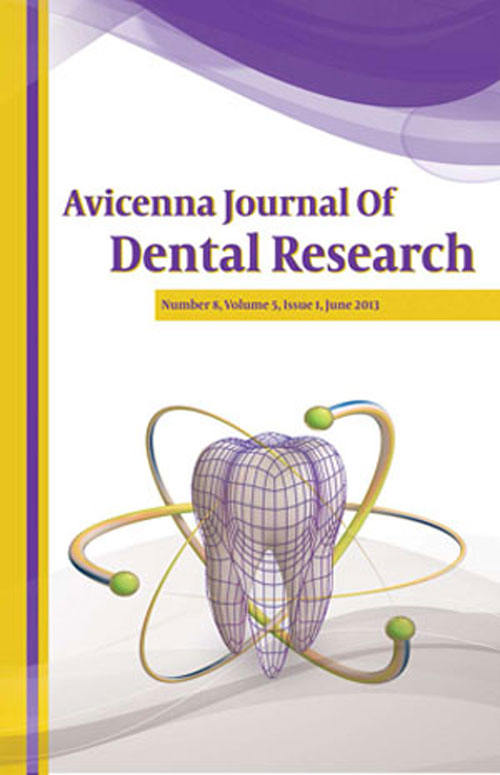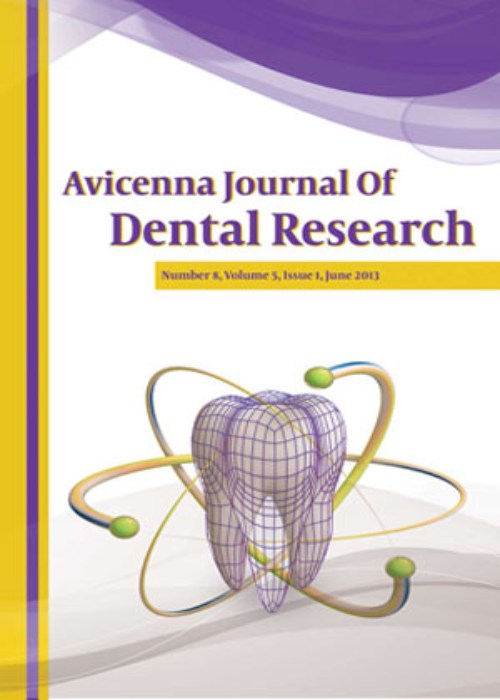فهرست مطالب

Avicenna Journal of Dental Research
Volume:7 Issue: 1, Jun 2015
- تاریخ انتشار: 1394/02/07
- تعداد عناوین: 7
-
-
Page 1BackgroundThe Immediate loading (IL) protocol has gained increased popularity among surgeons in the last decade..ObjectivesThis study aimed to evaluate the clinical performance of microtextured single-tooth implants using IL protocol six months after loading..Patients andMethodsIn this case series, SwissPlus implants (Zimmer Dental Inc, Carlsbad CA, USA) which was straight, self-tapping, 12 mm length and 4.1 mm diameter, were inserted into both jaws and single edentulous sites with clinically and radiologically healed bone by an experienced surgeon. In the test group (with IL protocol), one week after the surgery, the provisional crowns and abutments were loaded, and definitive restorations were delivered three months postoperatively. The factors including pain, mobility, probing depth (PD), bleeding on probing (BOP) and marginal bone loss (MBL) were investigated six months after the IL. The Mc Nemar and Wilcoxon tests were used for nominal variables and the paired ttest was also used for quantitative variables..ResultsTwenty-five implants were placed in 23 patients at Dental School, Shahed University, Tehran, Iran. The test group included 15 patients (16 implants) treated with immediately loaded single-tooth implants. The survival rate was 100% in both groups. In test, a significant reduction was measured in PD and pain; moreover, no statistically significant difference was noted between follow-ups with regard to mobility and BOP. The mean PD values six months for test and nine months for control after installation were 2.548 mm and 2.694 mm, respectively. Marginal bone loss was significantly decreased in the test group between the follow-ups..ConclusionsConsequently, this study shows promising results for IL of single implants, and it can be considerable that treatment with microtextured surface implants is a predictable and appropriate method of treatment..Keywords: Immediate Dental Implant Loading, Dental Implants, Single, Tooth, Microtextured Surface, SwissPlus Implant
-
Page 2BackgroundSjogren’s syndrome (SS) is a chronic autoimmune disease characterized by lymphocytic infiltration of exocrine glands, which can be triggered by environmental factors such as viral infection. Chronic obstructive sialadenitis is the most common type of chronic sialadenitis and many different bacterial infections develop as a result of ductal obstruction..ObjectivesThis study was conducted to assess the association of these lesions with the presence of Helicobacter pylori..Patients andMethodsA total of 56 biopsies diagnosed as Sjögren''s syndrome (SS) and chronic sialadenitis (CS) due to sialolithiasis in submandibular glands, sublingual and minor salivary glands were selected (56 samples as examined group and 20 samples as control group). All the paraffin blocks were cut for hematoxylin and eosin (H and E) staining to confirm the diagnoses and then the samples were prepared for immunohistochemistry (IHC) staining to detect H. pylori. Chi-squared test was used for statistical analysis..ResultsChi-squared test showed a significant difference between H. pylori positivity in the groups examined (P = 0.046) and between SS group and normal tissue samples (P = 0.013). There was no significant difference between gender and H. pylori positivity in examined groups examined (P = 0.574, P = 0.543, respectively). In addition, there was no significant difference between gender and H. pylori positivity in SS group (P = 0.119, P = 0.331, respectively) also in CS group (P = 0.981, P = 0.571)..ConclusionsBacterial infection has been suggested in the pathogenesis of both SS and CS. In addition, H. pylori is a resident of the oral cavity, thus may be involved in the development and progression of these lesions. Hence, search for H. pylori antibody in blood of patients with SS is suggested..Keywords: Sjogren's Syndrome, Chronic Sialadenitis, Helicobacter pylori, Oral Cavity
-
Page 3BackgroundFrom the ancient times, medicinal herbs have been regarded as efficient resources for the treatment of diseases. Among the diseases that can be treated by medicinal herbs, infectious diseases like oral ones are of notable importance..ObjectivesThe aim of this study was to evaluate the antibacterial effects of Ferula assa-foetida L (F. assa-foetida L.) and Quercus infectoria Olivier (Q. infectoria Olivier) aqueous and ethanolic extracts on Streptococcus mutans (S. mutans) and Streptococcus sanguis (S. sanguis)..Materials And MethodsThe studied plants were F. assa-foetida L. and Q infectoria Olivier. Their extracts with different concentrations of 100, 50, 25, 12.5, 6.25, and 3.125 mg/mL were prepared in culture medium, with well diffusion method, and, for control, their antibacterial effects were compared with chlorhexidine. For each extract, the antibacterial ability was determined based on the created inhibition zone diameter in the microbial culture medium..ResultsThe aqueous and ethanolic extract of F. assa-foetida L. lacked the inhibitory effect against the growth of S. mutans and S. sanguis bacteria. There was a significant difference among the inhibitory zones created by dissimilar concentrations of Q. infectoria (P = 0.025). Also, the aqueous and ethanolic extracts’ minimum inhibitory concentration (MIC) for S. mutans bacterium was calculated to be 12.5 mg/mL, while its value for S. sanguis bacterium was 6.25 mg/mL..ConclusionsThe results of our study, regarding the observed effects based on differences in concentrations, suggest that further and more comprehensive studies should be undertaken to determine the appropriate concentration for obtaining the effect of the extract of F. assa-foetida L. and Q infectoria Olivier on S. mutans and S. sanguis..Keywords: Herbals, Ferula, Streptococcus mutans, Streptococcus sanguis
-
Page 4BackgroundThe success of endodontic treatment depends on detection of all root canals so that they could be cleaned, shaped and obturated appropriately. To achieve this, it is essential to know root canals complexities such as the number of canals and types of each root canal, which are genetically determined. Besides, the highest failure rates occur in maxillary first molars..ObjectivesTherefore, the aim of this study was to investigate the root and canal morphology of maxillary first molars in an Iranian population using cone-beam computed tomography (CBCT)..Materials And MethodsIn this study, images of 156 extracted maxillary first molars placed in the waxed blocks were produced using CBCT. Two professional investigators checked images by NNT software in New Tom 3G system. Axial view and cross section of 1 mm thickness were used. The number of roots, canals, each roots canal, MB1-MB2 orifice distances and canal types of the Vertucci classification were recorded. Finally, data was analyzed using SPSS16 software..ResultsWe found 100% of cases with three separated roots, from which 69.23% had four canals including MB2 and 30.77% with three canals. 71.3% of mesiobuccal roots were two canals of type two Vertucci and 28.7% type 4 with the mean distance value of 2.55 ± 0.57 mm between MB1 and MB2 orifice..ConclusionsMost extracted maxillary first molars were three rooted and four canals. CBCT has relatively high reproducibility and accuracy of distinguishing MB2 canal..Keywords: Cone Beam Computed Tomography, Molars, Maxillae
-
Page 5BackgroundPeriapical lesions are induced in response to injuries to periapical tissues, which are generally the result of infections within the root canal. Mast cells actively participate to the inflammatory infiltration of periapical granulomas and cysts..ObjectivesThe aim of this study was to detect and compare the presence of mast cells in inflammatory periapical lesions, including cysts and granulomas..Materials And MethodsIn this cross-sectional study, 26 samples of inflammatory periapical lesions (17 cysts and nine granulomas) were stained with an immunohistochemical technique using CD117 (C-KIT) antibody to detect mast cells. Then, mast cell count (the number of mast cells in 0.2 mm2) and the intensity of mast cell staining were determined by two board certified pathologists. Fisher exact test and t-test were used for statistical analysis, with P < 0.05 for statistical significance..ResultsAlthough mast cells were observed in all samples, there were more numerous in periapical granulomas compared to periapical cysts, with no statistically significant difference (P = 0.076). The results also demonstrated that the staining in periapical cysts and granulomas were of strong and moderate intensity, respectively, without any significant difference (P = 0.411)..ConclusionsAccording to the results of this study, it appears that mast cells are present in all the investigated inflammatory periapical lesions and might play a role in the pathogenesis of these lesions..Keywords: Mast Cells, Radicular Cyst, Periapical Granuloma, CD117 Antigen
-
Page 6BackgroundStudying dentistry environment is important to assess stress causes, which is harmful for educational system..ObjectivesThe present study was accomplished to evaluate the level of stress caused by studying environment and related factors in dental students of Yazd, IR Iran..Materials And MethodsThis was a cross-sectional study accomplished on 150 dental students. Data collecting tools were the specific and standard questionnaire “Dental Environment Stress (DES)” and demographic questionnaire. For statistical analysis, t-test, analysis of variance (ANOVA), Tukey post hoc test and Pearson correlation coefficient test were used. Collected data was analyzed using SPSS ver.17..ResultsThe total average of stress score was 1.4 ± 0.6 (Maximum: 4). Among the stressful fields, the maximum and minimum averages were related to academic job (1.8 ± 0.8) and personal factor (1.07 ± 0.7). Besides, there was a statistical significant difference in the average of stress score between girl and boy students (P = 0.04). In addition, there was a statistical significant difference between student’s stress score in different academic years (P = 0.003), which was significantly more in students of fifth and sixth years of study..ConclusionsStress had a moderate level in dental students of study, which requires more attention. Due to the most level of stress in students of fifth and sixth years, it is recommended to take specific actions for this sensitive period of dentistry education..Keywords: Stress Disorders, Traumatic, Acute, Dentistry, Mental Health
-
Page 7IntroductionCalcifying odontogenic cyst (COC) is an uncommon odontogenic lesion, classified in two variants: the cystic variant and neoplastic (solid) variant..Case PresentationThis case report presents multiple COC, which involved the maxillary bone and sinus in a 30-year-old man. Several of these lesions were cystic, while the others were neoplastic in type, and the lesions were removed surgically..DiscussionBased on a literature review available on this topic in English, our case study was found to be the first one with multiple COC, showing both the cystic and neoplastic histopathological variant. Considering the high rate of recurrence of neoplastic COC, the patients should benefit from a long follow-up after treatment..Keywords: Cysts, Odontogenic Cyst, Calcifying, Maxillary Sinus


